Class notes
ALL lectures Brand Management
- Course
- Institution
ALL lectures for the course Brand Management in one document, including some exam tips and mock questions. Good luck with the exam! Take a look at the other documents that I sell!
[Show more]



